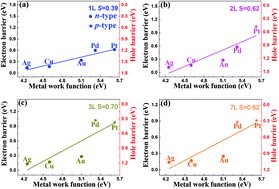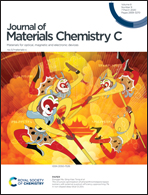Metal–2D multilayered semiconductor junctions: layer-number dependent Fermi-level pinning†
Abstract
The thickness-dependent performances of metal–two-dimensional (2D) semiconductor junctions in electronics/optoelectronics have attracted increasing attention but, currently, little knowledge about the micro-mechanism of this thickness (or layer-number) dependence is available. Here, by first-principles calculations based on density functional theory, we show that the Fermi-level pinning (FLP) factor of a metal–2D multilayered semiconductor junction (MmSJ) has a sensitive dependence on the layer-number of the MmSJ for few-layer 2D semiconductors, in a proposed extension of FLP theory. Taking a MmSJ with MoS2 as a typical example, we find that strong pinning arises right at the metal–1st-layer semiconductor interface, while depinning occurs between the MoS2 layers. The depinning effect mainly contributes to the variation of the FLP factor as a function of the layer-number of the semiconductor, making p-type Schottky barrier contact more favorable in MmSJs than in metal–2D monolayer semiconductor junctions, especially for large work-function metals. Moreover, our results shed light on recent controversial experimental observations relating to MmSJs and metal–2D monolayer semiconductor junctions.



 Please wait while we load your content...
Please wait while we load your content...